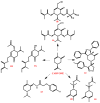Biological Activity of Monoterpene-Based Scaffolds: A Natural Toolbox for Drug Discovery
- PMID: 40286078
- PMCID: PMC11990750
- DOI: 10.3390/molecules30071480
Biological Activity of Monoterpene-Based Scaffolds: A Natural Toolbox for Drug Discovery
Abstract
One of the most common strategies used in drug design is the molecular scaffold approach, which combines traditional medicine based on natural active compounds derived from plants with modern synthetic drug development. Designing new compounds based on natural skeletons enables extensive modifications of both bioavailability and biological activity. An excellent example of a natural molecular scaffold is the monoterpenes group, which serves as a core structure for building more complex molecules by attaching various chemical groups. Their ability to interact with biological targets, combined with structural versatility, makes them promising molecular scaffolds in pharmaceutical research and green chemistry applications. This review paper focuses on selected monoterpenes (carvacrol, carvone, citral, menthol, menthone, β-pinene, thymol, and verbenone), which are frequently used as molecular scaffolds. The newly designed derivatives exhibit various biological activities, including anticancer, antibacterial, antiviral, neuroprotective, and many others.
Keywords: carvacrol; carvone; citral; menthol; menthone; molecular scaffold; monoterpenes; thymol; verbenone; β-pinene.
Conflict of interest statement
The authors declare no conflicts of interest.
Figures









Similar articles
-
Selected Monocyclic Monoterpenes and Their Derivatives as Effective Anticancer Therapeutic Agents.Int J Mol Sci. 2021 Apr 30;22(9):4763. doi: 10.3390/ijms22094763. Int J Mol Sci. 2021. PMID: 33946245 Free PMC article. Review.
-
Combination of synthetic anthelmintics and monoterpenes: Assessment of efficacy, and ultrastructural and biophysical properties of Haemonchus contortus using atomic force microscopy.Vet Parasitol. 2021 Feb;290:109345. doi: 10.1016/j.vetpar.2021.109345. Epub 2021 Jan 7. Vet Parasitol. 2021. PMID: 33482425
-
Unlocking the Pharmacological Potential of Benzimidazole Derivatives: A Pathway to Drug Development.Curr Top Med Chem. 2024;24(5):437-485. doi: 10.2174/0115680266283641240109080047. Curr Top Med Chem. 2024. PMID: 38311918 Review.
-
Antifungal activity of phenolic monoterpenes and structure-related compounds against plant pathogenic fungi.Nat Prod Res. 2019 May;33(10):1423-1430. doi: 10.1080/14786419.2017.1419232. Epub 2018 Jan 15. Nat Prod Res. 2019. PMID: 29334264
-
Anti-influenza activity of monoterpene-derived substituted hexahydro-2H-chromenes.Bioorg Med Chem. 2016 Nov 1;24(21):5158-5161. doi: 10.1016/j.bmc.2016.08.037. Epub 2016 Aug 22. Bioorg Med Chem. 2016. PMID: 27591012
Cited by
-
Antibacterial activity of a conventional hydrogel and a nanoparticle based hydrogel containing Satureja khuzestanica essential oil.Sci Rep. 2025 Jul 1;15(1):21267. doi: 10.1038/s41598-025-06160-0. Sci Rep. 2025. PMID: 40594892 Free PMC article.
References
Publication types
MeSH terms
Substances
LinkOut - more resources
Full Text Sources
Medical

